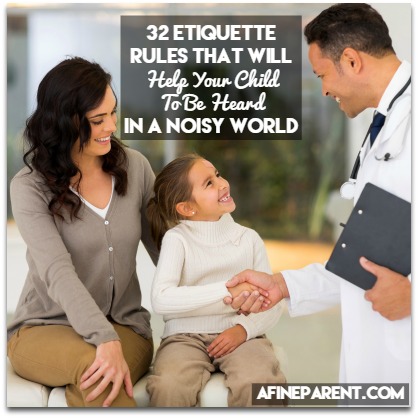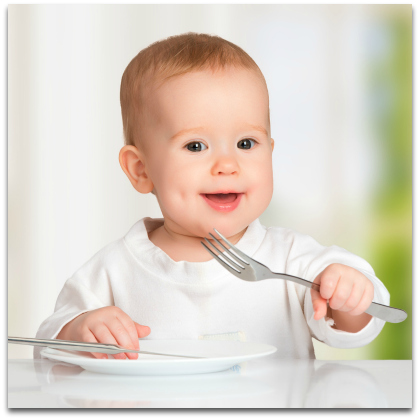 Have you ever wondered what it must be like to be a child in today’s busy grown-up world?
Have you ever wondered what it must be like to be a child in today’s busy grown-up world?
What with the information age and the incessant noise, it is hard enough for grownups to be heard. Can you imagine how much harder it must be for kids?
As an anthropologist, I will tell you this – good manners make it a lot easier to cut through the noise and be heard. Manners are the social glue that allows disparate members of society to come together. Adults need to teach children this language, which is essentially what social etiquette is, so they can communicate with peers and adults in order to give them the most advantages in life.
I have worked the last seven years in Children’s Ministry and Early Childhood Education, and I have observed that adult responses, both positive and negative, are based on basic manners.
I have noticed that even children with conditions or special needs that require extra patience and love from caregivers can elicit consistently positive adult responses and increased patience simply by following basic etiquette rules. My middle child falls into this category, and we have maximized her teachers’ patience by insisting on her use of the communicative language that is etiquette.
All children deserve the very best start in life, and a positive interaction with the adults in their lives helps children develop a healthy self-esteem. This in turn begets more positive interactions, and so on and so forth.
And of course, the opposite is true of negative interactions.
Because of this, giving kids a common language and a set of guidelines to navigate interactions is really giving them the tools to make themselves be heard, nurture faith in their own capabilities and set them up for future success.
So, here is a list of 32 etiquette rules that all parents should teach their children –
Greetings and Farewells
 These are the etiquette rules that even adults could use a refresher course on. Being consistent and practicing potential social situations will result in basic positive conversation that becomes second nature:
These are the etiquette rules that even adults could use a refresher course on. Being consistent and practicing potential social situations will result in basic positive conversation that becomes second nature:
1. Greet someone by their name if you know it and ask them if you don’t: Greeting someone by name is a sign of respect. It also indicates that the person is valued. Because of this, teach children to always greet an adult by the requested name or ask if they don’t know it. (As an aside, very few adults still insist that you call them by Miss, Mrs. or Mr. and then their last name. But, if you aren’t sure, it is always a good idea to ask.)
2. Don’t ever be afraid to ask again if you have forgotten: People understand that sometimes you forget names. Everyone does. It is always ok to say, “I am so sorry, I can’t remember you name, could you please remind me?”
3. Always look them in the eye: Looking someone in the eye when you are talking with that person is a good rule for everyone, not just children. Additionally, teach your kids to best avoid distraction; it signals to the person to whom they are speaking that he or she is not important. Looking someone in the eye is a simple but effective way to help your children win over the hearts of every adult they meet.
4. “It’s nice to see you.”: Adding positive comments to the beginning of a conversation is important. Examples of such comments are, “It’s nice to see you,” or “What a pleasure to run in to you.” Going beyond the standard greeting shows that your child values the person they are speaking with.
5. “Thanks for having me:” Whether at parties, playdates, Vacation Bible School, childcare or Grandma’s house, you should teach your child to thank the person for inviting them, having them over, or taking care of them; they will be going two steps beyond a simple thank you as a result. It shows gratitude, which is a value frequently agonized over as lacking in today’s youth. It is a definite winner with the adults in your child’s life.
6. “How are you…” and wait for the answer: We all use the automatic “Hey, how are you?” But what we often forget is to stop and wait for the answer. Teaching your children to ask, and then listen, is the first step to the next etiquette rule.
7. Remembering details and active listening: This is one etiquette rule that is simple to do but has a meaningful impact on people’s perceptions. Taking the time to remember names and specific details (such as an illness or the recent return from a vacation) implies care and respect.
Additionally, if you have a child who is super shy and hides behind your legs every time you meet someone, it is ok to respect that… to a point. In reality, those are the kids that need these “scripts” or language of social interaction the most.
My suggestion would be to pick just one to start with, such as looking someone in the eye and saying hello, even from behind your legs if necessary, and work upwards from there. Start slowly.
What is never necessary is forcing the child to hug and kiss or otherwise physically engage with family member or a friend. It is perfectly socially acceptable to smooth over an offended relative’s feelings by saying, “I am sure he will warm up to you in a bit. Let’s not force the issue at this time.”
Physical Space
 Children are very physical beings. They love to run, jump, tumble and play. Add in the fact that they have limited impulse control and are quick on their feet and you have a recipe for disaster when it comes to interacting with adults, especially adults who are not used to or simply don’t like being around kids. By teaching your child the following physical etiquette rules, you can assure your child can achieve success and impress even the least forgiving adults:
Children are very physical beings. They love to run, jump, tumble and play. Add in the fact that they have limited impulse control and are quick on their feet and you have a recipe for disaster when it comes to interacting with adults, especially adults who are not used to or simply don’t like being around kids. By teaching your child the following physical etiquette rules, you can assure your child can achieve success and impress even the least forgiving adults:
8. Be aware- Stop and Look: Children are often blissfully unaware of their surroundings. They tend to jump from one impulse to the next. For example, I took my kids to the zoo once and while we were at one exhibit visiting the elephants, they suddenly saw something interesting across the way. Without a thought to their surroundings, they dashed across the path, nearly causing an accident with an older gentleman in a wheelchair; he came very close to running over my two-year-old, barely stopping in time. The gentleman was extremely shaken and understandably angry. I apologized as best I could, but from that point on I vowed to remind my children constantly to stop and look both ways before moving, not just across the street, but everywhere.
9. Red Light, Yellow Light, Green Light: You may have noticed that teachers, swim instructors, soccer coaches and many other adults in your children’s lives use this valuable tool. Using the green light as “go,” yellow light to indicate “slow down” and red light for “stop,” you can control your children’s movements without yelling. Start out as early as you can and sell it as a game. Soon, after enough practice, it will become second nature and they will learn where it is okay to “go,” where it is necessary to “slow down” and where they must “stop.”
10. Hands off the glass: This one always seemed like a silly etiquette rule to me. I heard about adults complaining when children put their hands on glass surfaces and how irritating it was, and I thought it was just an example of people being overly particular. I thought this right up to the point when I was required to keep the front window clean at a job I held. It got to the point where I would cringe every time I saw a baby toddle up to the window with fingers wet from teething or eating something, resisting the urge to dramatically jump the counter and stop the child. Teach your kids not to put their hands on glass and your local banker, dance teacher, store owner, librarian, doctor’s receptionist etc. will thank you.
11. Don’t grab: I have very vivid memories of my mom gently taking things back that she had just handed me and starting over… again and again. I have seen her do it with my children. I understood its importance as an etiquette rule, but I never really understood the safety aspect until my friend’s son, not quite 2, grabbed a knife out of her hand. After that, I realized that not grabbing is not just an etiquette issue, it is a safety issue. If your child is a grabber, take back what he or she grabbed but do so gently, then nicely hand it to them again. Do this until your child knows that it is never acceptable to grab from anyone.
Eating (At the Table!)
 Eating is actually a landmine area for etiquette. It is one of the most critically important, as well as the one area where specifics can change depending on culture and company. As children grow, they eat quite frequently with other people. They attend birthday parties, spend time with relatives, have holiday dinners, and go over to friends’ homes for playdates and sleepovers. Eating is the one etiquette area that can be started as soon as a baby is born.
Eating is actually a landmine area for etiquette. It is one of the most critically important, as well as the one area where specifics can change depending on culture and company. As children grow, they eat quite frequently with other people. They attend birthday parties, spend time with relatives, have holiday dinners, and go over to friends’ homes for playdates and sleepovers. Eating is the one etiquette area that can be started as soon as a baby is born.
Things like lunging at the breast in anticipation of nursing or grabbing the bottle from Mom’s hands is the perfect place to start; pull baby back, gently explain patience and start again. Babies that young won’t understand your words, but eventually they learn that if they grab the bottle before it is offered or shove a hand under your shirt trying to nurse, that they aren’t going to get what they want.
Toddlers can be taught not to throw their food, how to use silverware and not to shove giant wads of food in their mouths. Preschoolers can be taught to set the table, to eat with proper manners and, when given the right tools, how to serve themselves.
Eating etiquette is critically important from the first playdate snack to your child’s first dinner with his or her boss. Social eating can be the place where your child’s success can be made or broken. The tips I have provided should arm your child with the most up-to-date tips on social eating:
12. Eating off of someone else’s plate – even Mom’s – isn’t a good idea: We have relatives who play a game in which they steal food off of each other’s plates. They all think it is hysterically funny and take pride in sneaking up and poaching food items from one another. That game might be fine at home when the whole family is in on it, but it is not so funny when it is done to someone who is not in on the joke. It is never okay to eat off someone else’s plate. It is just as easy to politely ask for more, even if that “more” ends up coming from Mom or Dad’s plate.
13. Don’t forget house rules: In our household you may ask to be excused from the table as soon as you are done eating. However, when we were visiting some friends on the West Coast, we quickly discovered that in their house the rule was that everyone had to sit at the table until the last person was finished. After that, my husband and I decided that we would teach our children to always ask about and follow any house rules when it comes to table etiquette.
14. The No-Thank-You Bite: We all have food we don’t care for. Thankfully the days are gone when we are expected to clean our plates regardless of what is in front of us. Instead, teach your kids to take a no-thank-you-bite of something to be respectful. Let them know that afterward it is okay to politely say, “I am sorry, I don’t really care for….,” or “…is not my favorite.” Make sure you let them know that is never okay to tell the person feeding them that they think something looks disgusting, gross or that they hate it (that includes Mom’s cooking).
15. “Can I help you with something?”: Not just for mealtime, this is a great all-around skill. It is especially polite, before or after being fed, to offer to help set or clear the table or dry the dishes.
16. Napkin in your lap/elbows off the table… usually: These are “old fashioned”’ etiquette rules that many people are more lax about these days. However, since children don’t always know what the house rules will be, teaching them to do these things will ensure they always err on the side of caution.
17. Don’t reach. An oldie but a goodie. Reaching across people to retrieve something out of reach is not just about etiquette. Every parent knows the frustration of a glass getting knocked over and spilling across the dinner table. Politely asking for something to be passed can avoid hot coffee in someone’s lap, and that makes everyone happy.
18. Excuse me from the table: This is a biggie! We make the children in our three-year-old preschool class do this. As soon as your child can speak, you should begin introducing him or her to the concept of excusing oneself from the table. This is not just for the end of the meal either; it applies every time your child needs to leave the table.
Hooray, Presents! (And Other Party/Guest Etiquette Rules)
 Parties are another time when your children have contact with others, often without parents. Because of this, hosting and attending parties are important moments to consider etiquette:
Parties are another time when your children have contact with others, often without parents. Because of this, hosting and attending parties are important moments to consider etiquette:
19. Invitations: Children’s birthday parties can be expensive. Because of this it is not always possible to invite everyone you would like. Teach your children to be discreet in passing out invitations and not to talk about the party in social settings unless everyone is invited.
20. RSVP: Just do it. I am guilty of this as well, but nothing is more frustrating than wondering if you have the correct amount of party supplies, including too little or way too much food. Text, email or call, it doesn’t matter how, just say if you can attend.
21. Being a good guest or a good host: It is never too early to teach kids to ask what their guests want to do, or to help pick up after a party. Teaching kids to make their guests welcome and comfortable will lay the groundwork for navigating future social situations in adulthood. Making sure your children understand how to be good guests will pave the way to future invitations.
22. I already have this; I didn’t want this…just say thank you: This one is self-explanatory. Teach your children to be polite, hide their disappointment and be grateful for the thought.
23. Find one nice thing to say about the gift: Taking the time to look someone in the eye and say thank you is a great rule, but if you are looking to maximize social impact, find one nice thing to say about the gift, even if it is only, “I can’t wait to use this.”
24. Thank you for coming/ Thank you for having me: Standard fare, but critically important.
25. Thank-you Notes: There are many creative ways to do this, but the simplest is to teach your children is to send handwritten notes to anyone who was not present at the time the gift was opened, anyone who has gone “above and beyond”, and any child who has taken the time to attend a birthday party for your child. They can be as simple as, “Thank you for [the gift], [one nice thing about the gift].” Preschoolers can “sign” their name, elementary school aged kids can copy or write their own notes.
Interacting with Adults
 While there is no arguing that children are more insulated now than in years past, all children will eventually have to interact with adults that are not parents. The following skills can help ease those interactions and make sure your children are always welcome:
While there is no arguing that children are more insulated now than in years past, all children will eventually have to interact with adults that are not parents. The following skills can help ease those interactions and make sure your children are always welcome:
26. Wait to be spoken to with elders: This is a very old-fashioned rule, and one that has fallen out of favor in recent decades. I posit, however, that in today’s technological world where it is hard to tell when an adult is busy (awkward Bluetooth moment anyone?) this is actually an important tool to ensure that children are not interrupting.
27. Teaching kids to identify the break in the conversation: Almost everyone knows to teach their children to say excuse me, but the 21st century moves fast, so you need to go one step further and teach your children to identify a lull in the conversation; it is then acceptable to interrupt.
28. Is it interruption worthy: So, your children know how to interrupt politely, now it is time to teach them to identify if it is even interruption worthy. Is it a kid-sized problem or an adult-sized problem?
Phone/Technology Etiquette Rules
 In today’s fast-paced, instant-access society it is absolutely crucial to mind your words, especially in print. In the age of screenshots, message forwarding, group messaging and accidental recipient foul-ups, it is important that words or pictures reach the person for whom they were intended.
In today’s fast-paced, instant-access society it is absolutely crucial to mind your words, especially in print. In the age of screenshots, message forwarding, group messaging and accidental recipient foul-ups, it is important that words or pictures reach the person for whom they were intended.
It is especially important to start teaching technology etiquette rules at a young age these days because so many elementary and middle school kids have access to or own their own cell phones. Internet-capable devices in the hands of younger children necessitate more diligence in determining what they are doing on them, and taking appropriate action if necessary. Here a few simple etiquette guidelines to consider:
29. Mind your words: Bullying used to be something that only happened in person. Most parents teach their children that is important to be kind in person, that it is important not to bully eye-to-eye (which is why it didn’t get its own section). However, making unkind comments and calling people names has now gone cyber, and often—if not usually—flies under the adult radar. Make sure your children understand that words can hurt.
30. Only send things that you wouldn’t mind becoming very public: We have all heard the stories of pictures or text messages being unintentionally sent to the wrong person or sent to the right person but still ending up in the wrong hands. Technology can be dangerous, and it is crucial that we teach kids to handle it with utmost caution. Pictures, texts and IM messages can take a dark turn and the Internet can be forever. Kids don’t always see the danger of damaging their reputation until it is too late.
31. Put your phone away in social situations: Seriously. I know it is hard. I am guilty of the same thing, but we need to teach children to be present in the moment. If we don’t teach them to focus on one task at a time now, they won’t have a chance when they get older. Teach them to focus rather than multi-task. Now, take the advice one step further and put your own phone down so that you can be present with your children. Turn off the ringer if you have to but take the time to show them that you value them by modeling best practices.
32. Hand signals can avoid phone interruptions, among other things: Teach hand signals to avoid phone interruptions. Now that personal devices have infiltrated the business world it is not uncommon for employees to be able to work from home, the park or the soccer field. To continue this trend, which is beneficial for all parents, it is important to teach ground rules to our children so that telephone conversations can be completed without unnecessary interruptions.
A great way to accomplish this is to teach kids hand signals. The signals can be specific to your family and your specific needs; you are only limited by your imagination. Hand signals are also great beyond phone conversations. Silent “no” or “stop” signals can curb behavior without having to shout across a room.
In Conclusion
Thank goodness the days of not wearing white after Labor Day, or standing every time a non-parental adult entered the room are long gone.
That said, in today’s new world, etiquette rules are more streamlined, but even more indispensable. The fantastic thing is, if you give your child these simple tools you will be amazed at the positive difference it makes in their ease of navigating the world around them.
Positive interactions beget a confident kid, and a confident kid is a happy kid who will grow up into a happy adult.
The 2-Minute Action Plan for Fine Parents
Take a quick minute to picture your child in a social situation. Do they exhibit some, or all of these etiquette guidelines? If not, it’s ok, kids are a work in progress. Pick one– just one– of the etiquette rules off the list and then start practicing. Practice makes perfect after all. As your child masters one, you can then add more in as you feel ready.
The Ongoing Action Plan for Fine Parents
Children grow and change, so it is important to do a periodic check-in with how well your child is “speaking” the language that is social etiquette. Depending on the need, this could be yearly, monthly, weekly and in some cases, daily. Children experiment with different behaviors over time, so don’t worry if you need to step back and get back to basics; it is all about the journey anyway.
Hi! I’m glad I found your website! This is just the very lesson my kids need right now. Wish I have known this site earlier, better late than never. Unfortunately the link for the printable quick reminder is not longer available. I will appreciate if you could email the file to me. Thanks in advance!
I like the point that says,
‘Eating off of someone else’s plate – even Mom’s – isn’t a good idea.’
My son, every time I sit to eat, if is after he has had his meal… he will always say, can I taste your food dad.
And if I walk away to the kitchen or something he serve himself… To be honest, I don’t fuss about it. I think as he is only three, he will grow stop by the time is five.
I used to be like you, Josh, thinking it is OK for my daughter to reach into my plate when she was very young. It has turned into a habit now and we are starting to enforce this rule a little more because it gets awkward when we go out with others at a restaurant and she reaches into my plate without any hesitation. What seems OK at home with just us seems very rude when we are outside and have company and my daughter doesn’t know better because we haven’t taught her! It is all a learning process — we just have to see what works and what does not and adapt accordingly.
Article is good and gives value addition to adults of parenting children. I wondered when the writer is discussing the etiquette to be maintained by the both the adult and children at the dining table specifically stating that one should not leave the table until the last finished eating. Certainly this we have to teach the children at young.
Glad you liked article, Dr. Srinivas. Thanks for your comment.
Great article Amie! These are all the things I have taught my daughters since birth. Now 18 & 13 I am so proud of them.
Technology etiquette to me is just plain common sense. Our oldest didn’t get a cell phone until 9th grade. We did allow gameboy and the ipod but they were not taken to school. We did slack a little when she got into high school.
Our 13 year old only has an ipod and gameboy she is not allowed to take either to school. I believe if she has to call me she can go to the office. We have also discussed a right and wrong time to text with both of them.
I know this does seem a little strict, but I think kids should be a little more mature before giving them a device that can give them too much information too fast.
That is interesting, Cheryl. Thanks for sharing!
I think as time goes by and it becomes almost a norm for every child to have a cell phone, it will become harder and harder to not let our kids have a phone. If your child is one of the few without a device (and the butt of the jokes of other kids) that could be as bad. We may not be there quite yet, but I feel we are definitely headed in that direction.
I would put off allowing my daughter to have a phone as much as possible (for the fact that it is too much information too fast as you say, and it keeps you from being present in the real world among real people!), but also put an effort to teach phone etiquette, so when she does get the phone she is familiar with it. For instance, I allow her to text her aunt and grand parents (my sister and parents) through my phone, which gives her a level of comfort with texting and gives me a chance to casually talk about what’s OK and what’s not. Just a thought.
I loved this article! I was nodding my head in agreement as I read each point. While I am a fairly young mother of a 4 and 6 year old, I grew up with “strict” parents that taught me the importance of the values you wrote about. I really love that you talk about starting practically from birth. No matter where I go, I seem to always get a compliment about how well behaved and polite my children are. But as you said, they have always been expected to show respect. And because of this, we are able to have so much fun together. The respect aspect is so engrained in them that I am not constantly correcting them or having to redirect. While I know this may not be the case with all parents, but we have never had to deal with a major tantrum from either of our kids ever. And now as they are getting older, a quick stern look of disapproval is all that is needed. Thanks for the article, especially the parts about interacting with adults. That is one area we could definitely improve on. 🙂
Glad you liked the article, Diana. I do believe it is very important to teach our kids to be respectful, but doing so without being overly strict or dictating it like it was done in the previous generations is so hard, right? I’ve been trying to model respect and go with the “you give respect, you get respect” approach – I’ve had some success and some colossal setbacks… keep trying and keep learning, I suppose 🙂
A friend of mine recounted on her blog about how when her 7 year old twins hid behind her legs or ran away when the handyman came over, he told them that was fine for 2, but not for 7. I think it can be hard to remember to adjust our expectations as our kids age, and I’ve been making a bigger effort to not let my son in particular get away with acting shy when he needs to start taking responsibility for more interactions, so I like the idea of giving kids a specific script to get them started. I also need to learn to butt out. I told my son that it would be nice when we got to his piano lesson to ask his teacher how she was doing, etc., and he simply said, “But you always do that.” What I thought of as modeling he saw as simply taking care of all of that. Anyway, nice piece with lots of good tips. Too often people think of etiquette as something fussy or pretentious, when most of the time it’s just an efficient way of being respectful of others.
That’s a good point, Korinthia — adjusting out expectations as our kids grow up. I have the opposite situation here though. When my daughter was younger I had taught her to ask the librarian for help to find a book and on our last visit, I had to firmly hold her back and tell her that she needs to put in a lot more effort in finding it herself before she could interrupt the librarian (again!). She uses her P’s and Q’s but in this context a little too many times 🙂 There’s always something new to teach (and learn!) isn’t it?
On your second point, Yes! I so agree that etiquette/manners are much more than just some random rules of propriety — they do tend to make things go more smoothly and efficiently, help you treat others respectfully and consequently earn the respect you deserve. That’s actually one of the reasons I loved this article by Amie and was so happy to publish it — instead of just a list of etiquette rules that we must teach our kids, she spoke of how/why it is helpful to teach these which made the article such much more useful IMO. Being the “editor” here (rather than the writer) and reading multiple articles on the same topic and seeing which one resonates with me has helped me learn so much too! 🙂
as Becca Ballinger says, it’s interrestin to stress the rules of using the new technologies…social networking, blogs, and so many kinds of surfing on the net make it somehow difficult to keep private what must be so…and many young people are not aware of the inconvenients…
Nice article and interresting points to remember and praxtice even fore adults…
I agree, Chems. This is a “newer” aspect of etiquette since most of us don’t have the experience of our parents teaching it to us, but we really need to hunker down and focus on teaching it to our kids!
Glad you liked the article and thanks for the comment 🙂
I would love to read some articles on how to handle kids and technology here on the blog Sumitha.
Yeah, I’m thinking about it too, Susan. We’ve covered it once before in a more general sense here but I want to see if we can put together an article about technology etiquette, some essential dos and dont’s and the best way to bring discuss this topic with kids. Thanks for this reminder! 🙂
As a mom of teens, the technology etiquette rules especially resonated with me. I think it’s s very important to teach our kids that having fancy phones, ipads, gaming things, etc. is a privilege and should never replace face-to-face communication with others. I try very hard to make sure my kids keep their “iThings” put away during social times at home and when we are away from home.
Great article! 🙂
You’re right, Becca! This is the one I dread the most – not only is this a matter of good etiquette, but the negative implications of a wrong text/photo/message in the wrong hands is just too scary to contemplate. And since so much technology in the hands of such young kids is all relatively new, I don’t know if we parents are really prepared enough to prepare our kids to handle it. *Shudder*
I agree with you… Sumitha and Becca,
Technology thing is so touch to deal with.
In the school where my children go here in the UK, the police came last term to talk to parents about the dangers of internetting and all that.
As parents we are trying to set rules around it but then again there is another thought of, this technology if for their future… shouldn’t we let them get used to it, flow with it as it’ll be the main thing when they are grown-ups, anyway.
Anyway, thanks for sharing a great post.
Even adults can be forced to learn new rules, when mingling with members of a different culture. I lost interest in going to my mother-in-laws dinner parties, when she indicated that it was impolite to speak with someone that was eating. By following that rule, I felt compelled to stay silent during a large part of the evening, although I was eager to speak with some of her guests.
Sue Chehrenegar
Sue, you are right — as adults, we need to constantly readjust based on who we’re in the company of. For some, a dinner party is a way to get together, talk, get to know each other better and generally have a good time. For others, dinners are more formal where we shouldn’t talk with food in our mouth (or as you mentioned to someone who is eating – that a new one for me, by the way!) I think I’d prefer the more open parties parties any day, but at the end of the day we have to follow the house rules of the host. I think starting to teach our kids about etiquette early will help them be able to make these distinctions and switch to house rules of the host more easily as and when required!